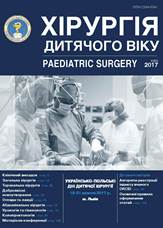Complication of intravesical correction of vesicoureteral reflux in children
DOI:
https://doi.org/10.15574/PS.2017.57.72Keywords:
vesicoureteral reflux, intravesical intervention, surgery complications, childrenAbstract
Objective. To reduce the percentage of complications in children after intravesical correction of VUR.Material and methods. The clinical material covers 270 patients with uni- and bilateral VUR II-IV grades, aged from 9 months to 14 years. Patients with VUR were collected complaints and anamnesis, a clinical examination, general clinical laboratory examinations with an assessment of the functional status of the glomerular apparatus and the degree of nephrosclerosis, ultrasound of the urinary tract and bladder with Doppler effect, retrograde cystography, excretory urography, dynamic angiography and renography with 99mTc-DTPA, cystoscopy. At the stage of clinical and laboratory remission patients underwent intravesical restored urodynamics – STING (subureteric injection), HIT (hydrodistention implantation technique), Double HIT, and, if necessary, their combination.
Results. In the early postoperative period 8 (2.96%) patients had a disorder of urodynamics with exacerbation of pyelonephritis, requiring more intensive and prolonged parenteral antibiotic therapy – more than 3 days. In 4 patients a dilatation of the ureter and pyelocaliceal system (PCS) with signs of urinary tract obstruction was revealed via the ultrasonography. These patients performed an intravesical internal stenting of ureter and PCS with JJ-stent for 1-3 months. In 2 patients in the late postoperative period an obstructive ureterohydronephrosis was diagnosed according to the urological X-ray examination, which required the ureterocystoneostomy. The clinical case of minimally invasive removal of concrement fragments from the left ureter after intravesical treatment of VUR III grade in both segments of the left double kidney in a 3-year-old patient, who was twice operated and the defect was successfully corrected. Obstructive uropathy after the injection of implant under the urethra orifice is the results of neuromuscular dysplasia of the urinary tract, which associated with fibrous tissue changes in the area of the uretero-vesical junction.
Conclusions. The endoscopic method is the most optimal way of treating VUR in children and its complications. However, intravesical treatment of VUR, as well as other methods of surgical intervention, also has various complications.
Downloads
Issue
Section
License
The policy of the Journal “PAEDIATRIC SURGERY. UKRAINE” is compatible with the vast majority of funders' of open access and self-archiving policies. The journal provides immediate open access route being convinced that everyone – not only scientists - can benefit from research results, and publishes articles exclusively under open access distribution, with a Creative Commons Attribution-Noncommercial 4.0 international license(СС BY-NC).
Authors transfer the copyright to the Journal “PAEDIATRIC SURGERY.UKRAINE” when the manuscript is accepted for publication. Authors declare that this manuscript has not been published nor is under simultaneous consideration for publication elsewhere. After publication, the articles become freely available on-line to the public.
Readers have the right to use, distribute, and reproduce articles in any medium, provided the articles and the journal are properly cited.
The use of published materials for commercial purposes is strongly prohibited.

